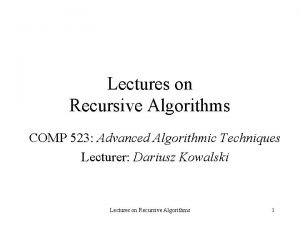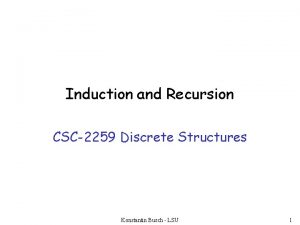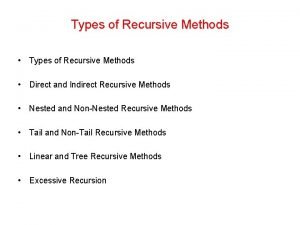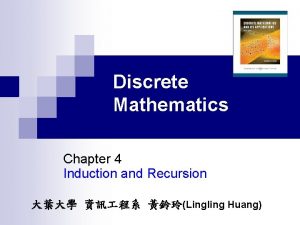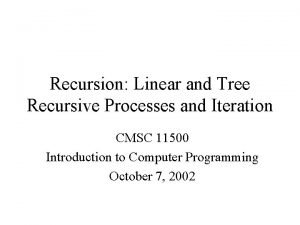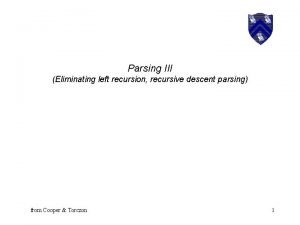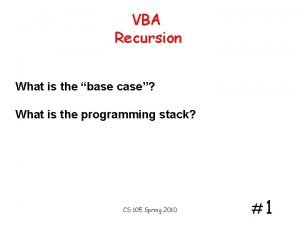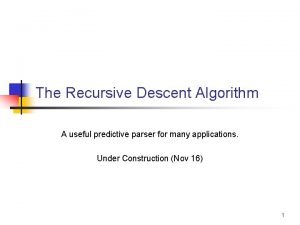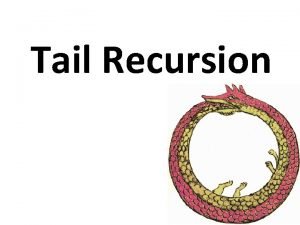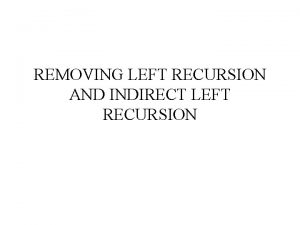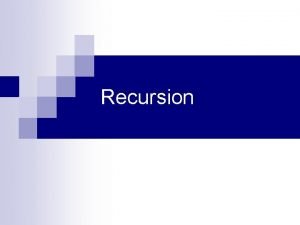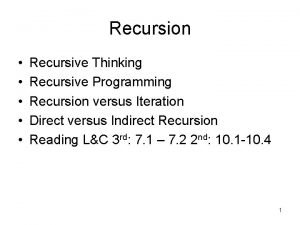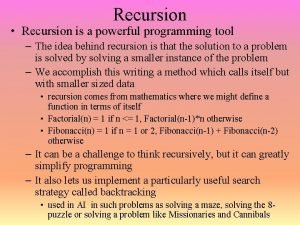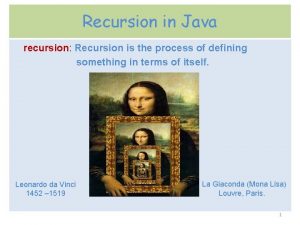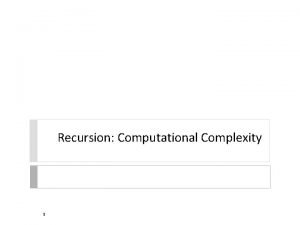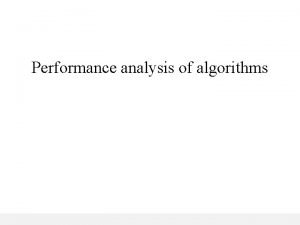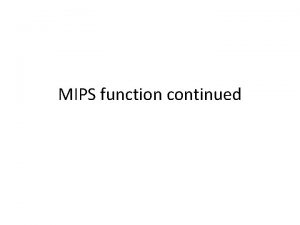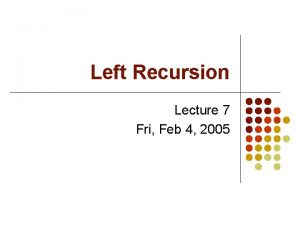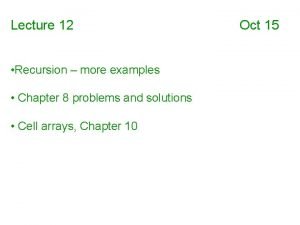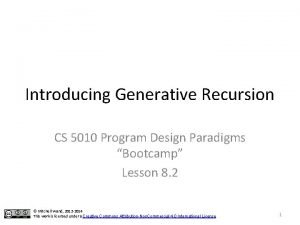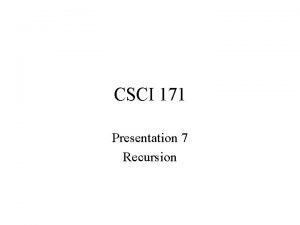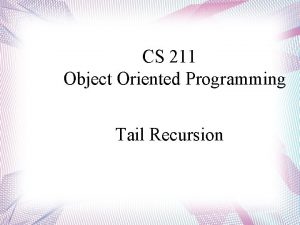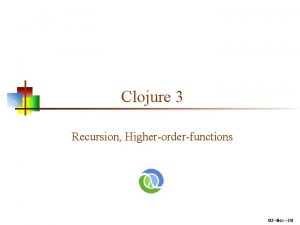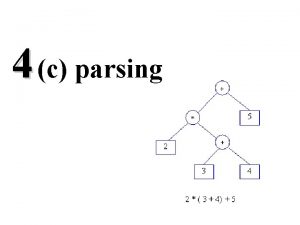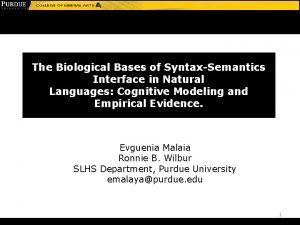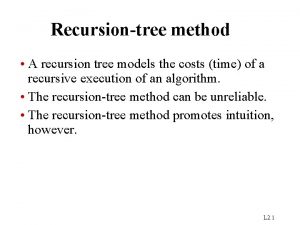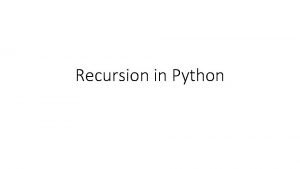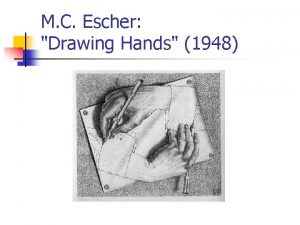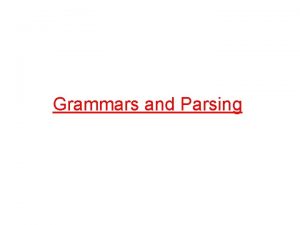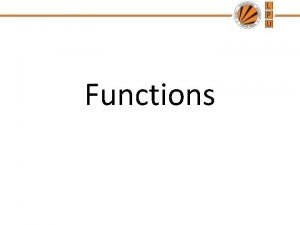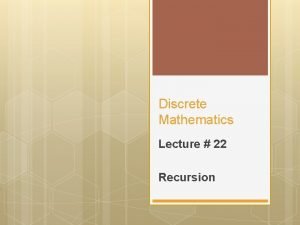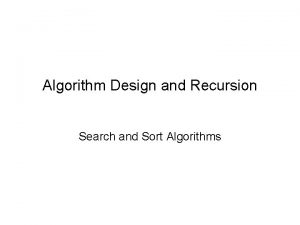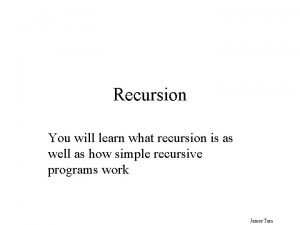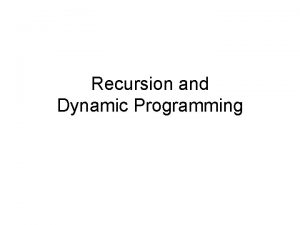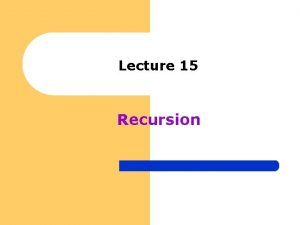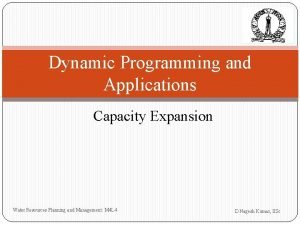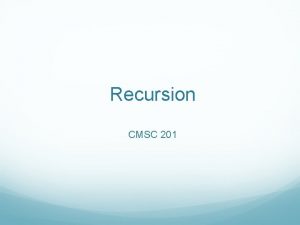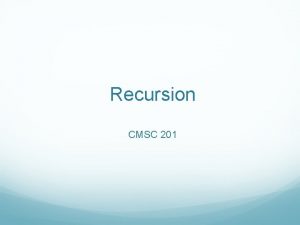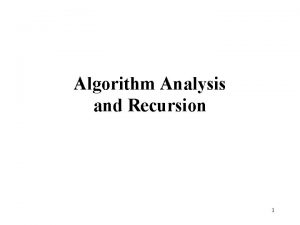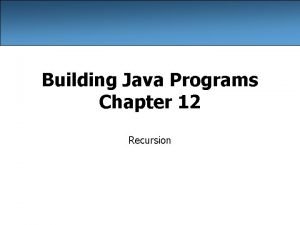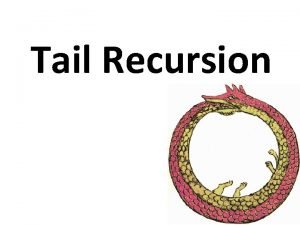Algorithm Analysis and Recursion 1 Algorithm An algorithm




















































![Sequential Search int sequential. Search(const int a[], int item, int n){ for (int i Sequential Search int sequential. Search(const int a[], int item, int n){ for (int i](https://slidetodoc.com/presentation_image_h/1606d5cecbac2a4e4b109399a61878cc/image-53.jpg)



- Slides: 56

Algorithm Analysis and Recursion 1

Algorithm • An algorithm is a set of instructions to be followed to solve a problem. – There can be more than one solution (more than one algorithm) to solve a given problem. – An algorithm can be implemented using different programming languages on different platforms. • An algorithm must be correct. It should correctly solve the problem. – e. g. For sorting, this means even if (1) the input is already sorted, or (2) it contains repeated elements. • Once we have a correct algorithm for a problem, we have to determine the efficiency of that algorithm. 2

Algorithmic Performance There are two aspects of algorithmic performance: • Time • Instructions take time. • How fast does the algorithm perform? • What affects its runtime? • Space • Data structures take space • What kind of data structures can be used? • How does choice of data structure affect the runtime? We will focus on time: – How to estimate the time required for an algorithm – How to reduce the time required 3

Analysis of Algorithms • Analysis of Algorithms is the area of computer science that provides tools to analyze the efficiency of different methods of solutions. • How do we compare the time efficiency of two algorithms that solve the same problem? Naïve Approach: implement these algorithms in a programming language (C++), and run them to compare their time requirements. Comparing the programs (instead of algorithms) has difficulties. – How are the algorithms coded? • Comparing running times means comparing the implementations. • We should not compare implementations, because they are sensitive to programming style that may cloud the issue of which algorithm is inherently more efficient. – What computer should we use? • We should compare the efficiency of the algorithms independently of a particular computer. – What data should the program use? • Any analysis must be independent of specific data. 4

Analysis of Algorithms • When we analyze algorithms, we should employ mathematical techniques that analyze algorithms independently of specific implementations, computers, or data. • To analyze algorithms: – First, we start to count the number of significant operations in a particular solution to assess its efficiency. – Then, we will express the efficiency of algorithms using growth functions. 5

The Execution Time of Algorithms • Each operation in an algorithm (or a program) has a cost. Each operation takes a certain of time. count = count + 1; take a certain amount of time, but it is constant A sequence of operations: count = count + 1; sum = sum + count; Cost: c 1 Cost: c 2 Total Cost = c 1 + c 2 6

The Execution Time of Algorithms (cont. ) Example: Simple If-Statement Cost if (n < 0) c 1 absval = -n c 2 else absval = n; c 3 Times 1 1 1 Total Cost <= c 1 + max(c 2, c 3) 7

The Execution Time of Algorithms (cont. ) Example: Simple Loop i = 1; sum = 0; while (i <= n) { i = i + 1; sum = sum + i; } Cost c 1 c 2 c 3 c 4 c 5 Times 1 1 n+1 n n Total Cost = c 1 + c 2 + (n+1)*c 3 + n*c 4 + n*c 5 The time required for this algorithm is proportional to n 8

The Execution Time of Algorithms (cont. ) Example: Nested Loop Cost c 1 c 2 c 3 c 4 c 5 c 6 c 7 Times 1 1 n+1 n n*(n+1) n*n i=1; sum = 0; while (i <= n) { j=1; while (j <= n) { sum = sum + i; j = j + 1; } i = i + 1; c 8 n } Total Cost = c 1 + c 2 + (n+1)*c 3 + n*c 4 + n*(n+1)*c 5+n*n*c 6+n*n*c 7+n*c 8 The time required for this algorithm is proportional to n 2 9

General Rules for Estimation • Loops: The running time of a loop is at most the running time of the statements inside of that loop times the number of iterations. • Nested Loops: Running time of a nested loop containing a statement in the inner most loop is the running time of statement multiplied by the product of the sized of all loops. • Consecutive Statements: Just add the running times of those consecutive statements. • If/Else: Never more than the running time of the test plus the larger of running times of S 1 and S 2. 10

Algorithm Growth Rates • We measure an algorithm’s time requirement as a function of the problem size. – Problem size depends on the application: e. g. number of elements in a list for a sorting algorithm, the number users for a social network search. • So, for instance, we say that (if the problem size is n) – Algorithm A requires 5*n 2 time units to solve a problem of size n. – Algorithm B requires 7*n time units to solve a problem of size n. • The most important thing to learn is how quickly the algorithm’s time requirement grows as a function of the problem size. – Algorithm A requires time proportional to n 2. – Algorithm B requires time proportional to n. • An algorithm’s proportional time requirement is known as growth rate. • We can compare the efficiency of two algorithms by comparing their growth rates. 11

Algorithm Growth Rates (cont. ) Time requirements as a function of the problem size n 12

Common Growth Rates Function c log N log 2 N N N log N N 2 N 3 2 N Growth Rate Name Constant Logarithmic Log-squared Linear Log-linear Quadratic Cubic Exponential

Running time Running Times for Small Inputs Input size (x = n) 14

Running time Running Times for Large Inputs Input size (x = n) 15

Order-of-Magnitude Analysis and Big O Notation • If Algorithm A requires time proportional to g(n), Algorithm A is said to be order g(n), and it is denoted as O(g(n)). • The function g(n) is called the algorithm’s growth-rate function. • Since the capital O is used in the notation, this notation is called the Big O notation. • If Algorithm A requires time proportional to n 2, it is O(n 2). • If Algorithm A requires time proportional to n, it is O(n). 16

Definition of the Order of an Algorithm Definition: Algorithm A is order g(n) – denoted as O(g(n)) – if constants k and n 0 exist such that A requires no more than k*g(n) time units to solve a problem of size n n 0. f(n) ≤ k*g(n) for all n n 0 • The requirement of n n 0 in the definition of O(f(n)) formalizes the notion of sufficiently large problems. – In general, many values of k and n can satisfy this definition. 17

Order of an Algorithm • If an algorithm requires f(n) = n 2– 3*n+10 seconds to solve a problem size n. If constants k and n 0 exist such that k*n 2 > n 2– 3*n+10 for all n n 0. the algorithm is order n 2 (In fact, k is 3 and n 0 is 2) 3*n 2 > n 2– 3*n+10 for all n 2. Thus, the algorithm requires no more than k*n 2 time units for n n 0 , So it is O(n 2) 18

Order of an Algorithm (cont. ) 19

Order of an Algorithm • Show 2 x + 17 is O(2 x) • 2 x + 17 ≤ 2 x + 2 x = 2*2 x for x > 5 • Hence k = 2 and n 0 = 5 20

Order of an Algorithm • Show 2 x + 17 is O(3 x) • 2 x + 17 ≤ k 3 x • Easy to see that rhs grows faster than lhs over time k=1 • However when x is small 17 will still dominate skip over some smaller values of x by using n 0 = 3 • Hence k = 1 and n 0 = 3 21

Definition of the Order of an Algorithm Definition: Algorithm A is omega g(n) – denoted as Ω(g(n)) – if constants k and n 0 exist such that A requires more than k*g(n) time units to solve a problem of size n n 0. f(n) ≥ k*g(n) for all n n 0 22

Definition of the Order of an Algorithm Definition: Algorithm A is theta g(n) – denoted as �� (g(n)) – if constants k 1, k 2 and n 0 exist such that k 1*g(n) ≤ f(n) ≤ k 2*g(n) for all n n 0 (Drop the equalities and you get small o and small omega (ω) notations, respectively, e. g. , f(n) is o(g(n)) if f(n)<kg(n)) 23

Order of an Algorithm • Show f(n) = 7 n 2 + 1 is �� (n 2) • • You need to show f(n) is O(n 2) and f(n) is Ω(n 2) f(n) is O(n 2) because 7 n 2 + 1 ≤ 7 n 2 + n 2 ∀n ≥ 1 k 1 = 8 n 0 = 1 f(n) is Ω (n 2) because 7 n 2 + 1 ≥ 7 n 2 ∀n ≥ 0 k 2 = 7 n 0 = 0 Pick the largest n 0 to satisfy both conditions naturally k 1 = 8, k 2 = 7, n 0 = 1 24

A Comparison of Growth-Rate Functions 25

Growth-Rate Functions O(1) Time requirement is constant, and it is independent of the problem’s size. O(log 2 n) Time requirement for a logarithmic algorithm increases slowly as the problem size increases. O(n) Time requirement for a linear algorithm increases directly with the size of the problem. O(n*log 2 n) Time requirement for a n*log 2 n algorithm increases more rapidly than a linear algorithm. O(n 2) Time requirement for a quadratic algorithm increases rapidly with the size of the problem. O(n 3) Time requirement for a cubic algorithm increases more rapidly with the size of the problem than the time requirement for a quadratic algorithm. O(2 n) As the size of the problem increases, the time requirement for an exponential algorithm increases too rapidly to be practical. 26

Growth-Rate Functions • If an algorithm takes 1 second to run with the problem size 8, what is the time requirement (approximately) for that algorithm with the problem size 16? • If its order is: O(1) T(n) = 1 second O(log 2 n) T(n) = (1*log 216) / log 28 = 4/3 seconds O(n) T(n) = (1*16) / 8 = 2 seconds O(n*log 2 n) T(n) = (1*16*log 216) / 8*log 28 = 8/3 seconds O(n 2) T(n) = (1*162) / 82 = 4 seconds O(n 3) T(n) = (1*163) / 83 = 8 seconds O(2 n) T(n) = (1*216) / 28 = 28 seconds = 256 seconds 27

Properties of Growth-Rate Functions 1. We can ignore low-order terms in an algorithm’s growth-rate function. – If an algorithm is O(n 3+4 n 2+3 n), it is also O(n 3). – We only use the higher-order term as algorithm’s growth-rate function. 2. We can ignore a multiplicative constant in the higher-order term of an algorithm’s growth-rate function. – If an algorithm is O(5 n 3), it is also O(n 3). 3. O(f(n)) + O(g(n)) = O(f(n)+g(n)) – We can combine growth-rate functions. – If an algorithm is O(n 3) + O(4 n), it is also O(n 3 +4 n 2) So, it is O(n 3). – Similar rules hold for multiplication. 28

Growth-Rate Functions – Example 1 i = 1; sum = 0; while (i <= n) { i = i + 1; sum = sum + i; } Cost c 1 c 2 c 3 c 4 c 5 Times 1 1 n+1 n n T(n) = c 1 + c 2 + (n+1)*c 3 + n*c 4 + n*c 5 = (c 3+c 4+c 5)*n + (c 1+c 2+c 3) = a*n + b So, the growth-rate function for this algorithm is O(n) 29

Growth-Rate Functions – Example 3 for (i=1; i<=n; i++) for (j=1; j<=i; j++) for (k=1; k<=j; k++) x=x+1; T(n) = So, the growth-rate function for this algorithm is O(n 3) 30

Growth-Rate Functions – Example 2 Cost c 1 c 2 c 3 c 4 c 5 c 6 c 7 Times 1 1 n+1 n n*(n+1) n*n i=1; sum = 0; while (i <= n) { j=1; while (j <= n) { sum = sum + i; j = j + 1; } i = i +1; c 8 n } T(n) = c 1 + c 2 + (n+1)*c 3 + n*c 4 + n*(n+1)*c 5+n*n*c 6+n*n*c 7+n*c 8 = (c 5+c 6+c 7)*n 2 + (c 3+c 4+c 5+c 8)*n + (c 1+c 2+c 3) = a*n 2 + b*n + c So, the growth-rate function for this algorithm is O(n 2) 31

Growth-Rate Functions – Example 3 • Fill in the boxes below 32

Growth-Rate Functions – Examples 4 -5 • For nxn matrices, time complexity is: O(n 3) • How about this one? O(logn) 33

Growth-Rate Functions – Example 6 • Fill in the boxes below 34

Growth-Rate Functions – Recursive Algorithms void hanoi(int n, char source, char dest, char spare) { //Cost if (n > 0) { //c 1 hanoi(n-1, source, spare, dest); //c 2 cout << "Move top disk from pole " << source //c 3 << " to pole " << dest << endl; hanoi(n-1, spare, dest, source); //c 4 } } • The time-complexity function T(n) of a recursive algorithm is defined in terms of itself, and this is known as recurrence equation for T(n). • To find the growth-rate function for a recursive algorithm, we have to solve its recurrence relation. 35

Growth-Rate Functions – Hanoi Towers • What is the cost of hanoi(n, ’A’, ’B’, ’C’)? when n=0 T(0) = c 1 when n>0 T(n) = c 1 + c 2 + T(n-1) + c 3 + c 4 + T(n-1) = 2*T(n-1) + (c 1+c 2+c 3+c 4) = 2*T(n-1) + c recurrence equation for the growth-rate function of hanoi-towers algorithm • Now, we have to solve this recurrence equation to find the growth-rate function of hanoi-towers algorithm 36

Growth-Rate Functions – Hanoi Towers (cont. ) • There are many methods to solve recurrence equations, but we will use a simple method known as repeated substitutions. T(n) = 2*T(n-1) + c = 2 * (2*T(n-2)+c) + c = 2 * (2*T(n-3)+c) + c = 23 * T(n-3) + (22+21+20)*c (assuming n>2) when substitution repeated i-1 th times = 2 i * T(n-i) + (2 i-1+. . . +21+20)*c when i=n = 2 n * T(0) + (2 n-1+. . . +21+20)*c = 2 n * c 1 + ( )*c 2 a = 2 + 4 + 8 +. . + 2 n-1 + 2 n a = 1 + 2 + 4 + 8 +. . + 2 n-1 2 a – a is your result 2 n - 1 = 2 n * c 1 + ( 2 n-1 )*c = 2 n*(c 1+c) – c So, the growth rate function is O(2 n) 37

More Recursive Algorithms int fact(int n) { if (n ==0) return (1); else return (n * fact(n-1)); } T(n) = T(n-1) + c = (T(n-2) + c = (T(n-3) + c + c = (T(n-i) + i*c) when i=n T(0) + n*c T(n) = O(n)

Tracing the call fact (3) N = 0 if (N==0) true return (1) N = 1 if (N==0) false return (1*fact(0)) N = 2 if (N==0) false return (2*fact(1)) N = 3 if (N==0) false return (3*fact(2)) After original call After 1 st call After 2 nd call After 3 rd call 39 2/27/2021

Tracing the call fact (3) N = 1 if (N==0) false return (1* 1) N = 2 if (N==0) false return (2*fact(1)) N = 2 if (N==0) false return (2* 1) N = 3 if (N==0) false return (3*fact(2)) N = 3 if (N==0) false return (3* 2) After return from 3 rd call After return from 2 nd call After return from 1 st call 2/27/2021 return 6 40

More Recursive Algorithms bool is. Palindrome (string s) { if (s. length() <= 1) return true; return (s[0]==s[s. length()-1]) && is. Palindrome(s. substr(1, s. length()-2)); } T(n) = = = when = T(n-2) + c (T(n-4) + c (T(n-6) + c + c (T(n-i) + i/2*c) i=n T(0) + n/2*c T(n) = O(n)

More Recursive Algorithms int fib(int n) { //1 1 2 3 5 8 13 21 34. . }

More Recursive Algorithms int fib(int n) { //1 1 2 3 5 8 13 21 34. . if (n == 1) return 1; if (n == 2) return 1; else return fib(n-1) + fib(n-2); } T(n) = ?

More Recursive Algorithms int fib(int n) { //1 1 2 3 5 8 13 21 34. . if (n == 1) return 1; if (n == 2) return 1; else return fib(n-1) + fib(n-2); } T(n) = T(n-1) + T(n-2) + c = (T(n-2) + T(n-3) + c) + (T(n-3) + T(n-4) + c = gets nasty if we continue substituting; let’s be smarter.

More Recursive Algorithms int fib(int n) { //1 1 2 3 5 8 13 21 34. . if (n == 1) return 1; if (n == 2) return 1; else return fib(n-1) + fib(n-2); } T(n) = T(n-1) + T(n-2) + c < T(n-1) + c = O(2 n) as we showed in slide 37. This shows that it cannot exceed O(2 n), hence an upper bound.

More Recursive Algorithms int fib(int n) { //1 1 2 3 5 8 13 21 34. . if (n == 1) return 1; if (n == 2) return 1; else return fib(n-1) + fib(n-2); } T(n) = T(n-1) + T(n-2) + c < T(n-1) + c = O(2 n) as we showed in slide 37. This shows that it cannot exceed O(2 n), hence an upper bound. let’s go for the lower bound; if it’s (2 n), then T(n) is (2 n). T(n-1) + T(n-2) + c > T(n-2) + c //cos T(n-1) > T(n-2) slightly. T(n) = 2 T(n-2) + c = 2(2 T(n-4) + c = 4 T(n-4) + 3 c = 2(2(2 T(n-6) + c) + c = 8 T(n-6) + 7 c = = 16 T(n-8) + 15 c = 2 i. T(n-2 i) + (2 i-1) when i = n/2 2 n/2 T(0) + 2 n/2 -1 = (2 n) is the lower bound for T(n).

More Recursive Algorithms int fib(int n) { //1 1 2 3 5 8 13 21 34. . if (n == 1) return 1; if (n == 2) return 1; else return fib(n-1) + fib(n-2); } Alternative method. Lots of re-computations. Guess T(n) = O(2 n) ‘cos n n-1+n-2=2 n-3 doubling, seems to be exponential. You can also get this guess from the recursion tree. Assume T(n-1) = O(2 n-1), induction hypothesis. T(n) = T(n-1) + T(n-2) + O(1) = O(2 n-1) + O(2 n-2) + O(1) = O(2 n).

More Recursive Algorithms int fib(int n) { //1 1 2 3 5 8 13 21 34. . if (n == 1) return 1; if (n == 2) return 1; else return fib(n-1) + fib(n-2); } T(n) = O(2 n). Can you solve fib in O(n)?

More Recursive Algorithms int fibo(int n) { //1 1 2 3 5 8 13 21 34. . if (n == 1) return 1; if (n == 2) return 1; else return fibo(n-1) + fibo(n-2); } T(n) = O(2 n). Can you solve fib in O(n)? (Non-rec). a=1, b = c = 0; or recomputations avoided!

More Recursive Algorithms Count positive integers in an array recursively? int count. Pos(int* A, int j) { }

More Recursive Algorithms Count positive integers in an array recursively? int count. Pos(int* A, int j) { //1 st call count. Pos(A, n-1) if (j < 0) return 0; if (A[j] > 0) return 1 + count. Pos(A, j-1); else return 0 + count. Pos(A, j-1); } T(n) = T(n-1) + c T(n) = O(n) from slide 38. Iterative version is also O(n).

What to Analyze • An algorithm can require different times to solve different problems of the same size. – Eg. Searching an item in a list of n elements using sequential search. Cost: 1, 2, . . . , n • Worst-Case Analysis –The maximum amount of time that an algorithm require to solve a problem of size n. – This gives an upper bound for the time complexity of an algorithm. – Normally, we try to find worst-case behavior of an algorithm. • Best-Case Analysis –The minimum amount of time that an algorithm require to solve a problem of size n. – The best case behavior of an algorithm is NOT so useful. • Average-Case Analysis –The average amount of time that an algorithm require to solve a problem of size n. – Sometimes, it is difficult to find the average-case behavior of an algorithm. – We have to look at all possible data organizations of a given size n, and their distribution probabilities of these organizations. – Worst-case analysis is more common than average-case analysis. 52
![Sequential Search int sequential Searchconst int a int item int n for int i Sequential Search int sequential. Search(const int a[], int item, int n){ for (int i](https://slidetodoc.com/presentation_image_h/1606d5cecbac2a4e4b109399a61878cc/image-53.jpg)
Sequential Search int sequential. Search(const int a[], int item, int n){ for (int i = 0; i < n && a[i]!= item; i++); if (i == n) return – 1; return i; } Unsuccessful Search: O(n) Successful Search: Best-Case: item is in the first location of the array O(1) Worst-Case: item is in the last location of the array O(n) Average-Case: The number of key comparisons 1, 2, . . . , n O(n) 53

Binary Search We can do binary search if the array is sorted: int binary. Search(int a[], int size, int x) { int low =0; int high = size – 1; int mid; // mid will be the index of // target when it’s found. while (low <= high) { mid = (low + high)/2; if (a[mid] < x) low = mid + 1; else if (a[mid] > x) high = mid – 1; else return mid; } return – 1; } 54

Binary Search – Analysis • For an unsuccessful search: – The number of iterations in the loop is log 2 n + 1 O(log 2 n) • For a successful search: – Best-Case: The number of iterations is 1. O(1) – Worst-Case: The number of iterations is log 2 n +1 O(log 2 n) – Average-Case: The avg. # of iterations < log 2 n O(log 2 n) 0 3 1 2 2 3 3 1 4 3 5 2 6 3 an array with size 7 # of iterations The average # of iterations = 17/7 = 2. 4285 < log 27 For a proof of the general case see: http: //raider. mountunion. edu/~cindricbb/sp 06/340/avgbinsearch. html 55

How much better is O(log 2 n)? n 16 64 256 1024 16, 384 131, 072 262, 144 524, 288 1, 048, 576 1, 073, 741, 824 O(log 2 n) 4 6 8 10 14 17 18 19 20 30 56
 To understand recursion you must understand recursion
To understand recursion you must understand recursion Recursive time complexity
Recursive time complexity Recursion algorithm
Recursion algorithm Using recursion in models and decision making
Using recursion in models and decision making Iterative vs recursive
Iterative vs recursive Using recursion in models and decision making sheet 3
Using recursion in models and decision making sheet 3 Recursive pronouns
Recursive pronouns Induction and recursion discrete mathematics
Induction and recursion discrete mathematics Replace recursion with iteration
Replace recursion with iteration Linear and tree recursion
Linear and tree recursion Left factoring algorithm
Left factoring algorithm Vba recursion
Vba recursion What is recursion in language
What is recursion in language Recursive descent parser
Recursive descent parser Tail recursion
Tail recursion Eliminate indirect left recursion
Eliminate indirect left recursion Recursion error fanfic
Recursion error fanfic Box trace recursion
Box trace recursion Recursive thinking definition
Recursive thinking definition What is recursion can be a powerful tool for solving?
What is recursion can be a powerful tool for solving? How does recursion works
How does recursion works Recursion google
Recursion google Recursion time complexity
Recursion time complexity Recursion in java
Recursion in java Linear recursive
Linear recursive Box trace recursion
Box trace recursion Ap computer science recursion
Ap computer science recursion Prolog recursion
Prolog recursion English ruler recursion
English ruler recursion Recursion time complexity
Recursion time complexity Mips recursive
Mips recursive Left recursion definition
Left recursion definition Matlab recursion
Matlab recursion Generative recursion
Generative recursion Recursion
Recursion Recursion vs loop
Recursion vs loop Tail recursion
Tail recursion Recursion vs iteration
Recursion vs iteration Clojure tail recursion
Clojure tail recursion Assembly
Assembly Left recursion
Left recursion Telic recursion
Telic recursion Recursion tree example
Recursion tree example Python recursion practice
Python recursion practice Recursion in assembly language 8086
Recursion in assembly language 8086 Drawing hands 1948
Drawing hands 1948 Application of recursion
Application of recursion What is inline function in c++
What is inline function in c++ What is recursion in discrete mathematics
What is recursion in discrete mathematics Cs106b lectures
Cs106b lectures Selection sort using recursion
Selection sort using recursion Recursion
Recursion Recursive thinking definition
Recursive thinking definition Recursion
Recursion Recursion
Recursion Dynamic programming recursion example
Dynamic programming recursion example

